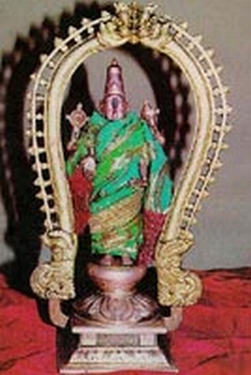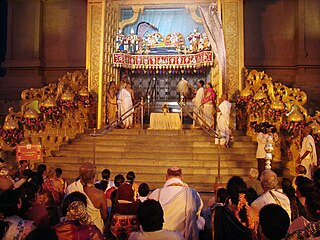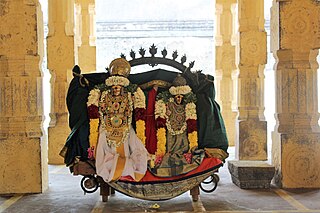Related Research Articles

Venkateswara, also known as Venkatachalapati, Balaji and Srinivasa, is a major deity in Hinduism. Described as an avatar of Vishnu, he is the presiding deity of Venkateshwara Temple, Tirupati. His consorts, Padmavathi and Bhudevi are avatars of Lakshmi.

Tirumala is a spiritual place in Tirupati district of the Indian state of Andhra Pradesh. It is one of the neighbourhoods of the Tirupati city. The town is a part of Tirupati Urban Development Authority and located in Tirupati (urban) mandal of Tirupati revenue division. It is a hill town where Tirumala Venkateswara Temple is located, a popular shrine of Vishnu. The town is strictly vegetarian.

Tirupati is a city in the Indian state of Andhra Pradesh. It is the administrative headquarters of the Tirupati district. The city is home to the important Hindu shrine of Tirumala Venkateshwara Temple and other historic temples. It is located at a distance of 150 km from Chennai, 250 km from Bangalore, 406 km from Amaravati. It is one of the eight Svayam vyakta kshetras dedicated to Hindu deity Vishnu. Tirupati is a municipal corporation and the headquarters of Tirupati (urban) mandal, Tirupati (rural) mandal, and the Tirupati revenue division.

Sri Venkateswara Swami vari Brahmotsavam or Srivari Brahmotsavam is the most significant annual fête celebrated at the Venkateswara Temple in Tirumala-Tirupati, Tirupati district, Andhra Pradesh, India. The feast lasts for one month during the Telugu - Hindu calendar month of Ashwayujamu, which falls between the Gregorian calendar months of September or October.

Ranganayaki, also known by her epithet Tayar, is a Hindu goddess. She is the presiding goddess of the Sri Ranganathaswamy temple at Srirangam. She is the chief consort of Ranganatha, the tutelary deity of Srirangam. The goddess is regarded as a manifestation of Lakshmi, while Ranganatha is considered as a manifestation of Vishnu. She is also called Ranganayaki Nachiyar and Periya Piratti.

The Sri Venkateswara Swami Temple is a Hindu temple situated in the hills of Tirumala at Tirupati in Tirupati district of Andhra Pradesh, India. The temple is dedicated to Venkateswara, a form of Vishnu, who is believed to have appeared on the earth to save mankind from trials and troubles of Kali Yuga. Hence the place is also known by the name Kaliyuga Vaikuntha and the deity here is referred to as Kaliyuga Prathyaksha Daivam. The temple is also known by other names like Tirumala Temple, Tirupati Temple and Tirupati Balaji Temple. Venkateswara is known by many other names: Balaji, Govinda, and Srinivasa. The temple is run by Tirumala Tirupati Devasthanams (TTD), which is under control of Andhra Pradesh Government. The head of TTD is appointed by Andhra Pradesh Government.
Kalyana Varadharaja Perumal Temple is a temple in Paruthiyur, Sengalipuram, Thiruvarur District, India. The temple is located on the banks of the Kudamurutti River, a distributary of the River Kaveri.

Malayappa Swami is the current utsava murti in the Tirumala Venkateswara Temple, Tirumala. Malayappa Swami is worshipped during religious ceremonies and processions wherein it would be inappropriate to use the main deity. The two deities are worshipped equally and believed to be non-different in personality.
For one of the major Hindu denominations, the Tirumala Sri Venkateshvara Temple at Tirupati in the Indian state of Andhra Pradesh is the most famous Vaishnavite temple in the world. The presiding deity of Vishnu here is referred to as Venkateshvara. There are many legends regarding this temple. The Sri Venkatachala Mahatyam is the most accepted legend among these, which provides the religious account of the history of the temple across various yugas. This place had also been mentioned in many Puranas.

Koluvu Srinivasa is an idol of Lord Venkateswara in the Tirumala Venkateswara Temple, Andhra Pradesh. This silver idol that resembles the main deity represents the presiding officer for all activities and rituals in the temple. Koluvu Srinivasa is regarded as the guardian deity of the temple and presides over all its financial and economic affairs. The idol is also called as Bali Bera. The duties of the Bali Bera closely resemble that of the householder. He manages the finances and accounts, and his permission is sought before offering Bali to Nityasuris like Garuda, Hanuman and Vishvaksena on the Balipeetham. There is no recorded history of the deity leaving the innermost 16-pillared hall.

Tirumala Krishna idol is one of the idols in the Tirumala Venkateswara Temple, Andhra Pradesh, India. While the temple is dedicated to worship of lord Vishnu as Venkateswara, it contains the idols of some of Vishnu's other avatars - Krishna and Rama. The temple also has the idol of Rukmini, wife of Lord Krishna.
Sri Venkateshwara Swami Temple is a landmark vaishnavite temple situated in the hill town of Tirumala at Tirupati in Chittoor district of Andhra Pradesh, India. The Temple is dedicated to Lord Venkateswara, an incarnation of Vishnu, who is believed to be appeared here to save mankind from the trials and troubles of Kali Yuga.

Vaikuntha Ekadashi is a Hindu occasion and festival. It is primarily observed by Vaishnavas, who regard it to be a special ekadashi. It coincides with Mokshada Ekadashi or Putrada Ekadashi. It is observed on the 11th lunar day of the waxing lunar fortnight of the solar month of Dhanu. This falls between 16 December and 13 January in the Gregorian calendar.

Nachiyar Kovil or Thirunarayur Nambi Temple is a Hindu temple in Thirunarayur, a village in the outskirts of Kumbakonam in the southern Indian state of Tamil Nadu, is dedicated to the Hindu god Vishnu and his wife Lakshmi. It is the sub urban region of business city of Kumbakonam.
Narasimha Temple is situated in Puri, Odisha, India, to the western side of Gundicha Temple and to the east of the Indradyumna tank.

In Hinduism, utsava murti, utsavar or uthsavar, is a form of a murti (icon) which represents a deity. The portable utsavar is employed in the tradition of temple processions, serving as a substitute for the central idol present in the temple shrine, called the mulavar.

A brahmotsava, also rendered mahotsava and tiruvila is the principal festival of a Hindu temple.

Vishvaksena or Vishwaksena, is the commander-in-chief of the army of the Hindu deity Vishnu, additionally serving as a gatekeeper and chamberlain of his celestial abode of Vaikuntha. As the embodiment of the tantras, Vishvaksena is worshipped before any ritual or function in the Vaikhanasas and Sri Vaishnavism sects. He occupies an important place in Vaikhanasa and Pancaratra temple traditions, where temple festivals often begin with his worship and procession.

The Kurmanathaswamy temple, also known as the Kurmanatha temple, Srikurma or Srikurmam temple, is a Hindu temple dedicated to Kurma – the second avatar of Vishnu. It is located in Srikurmam village, Srikakulam district in Andhra Pradesh, India. According to Prapannamrutam and earliest inscription of the temple, In saka 1035 CE Anantavarman Chodaganga Deva of Eastern Ganga Dynasty of Odisha converted this temple to a Vaishnava khetra from a Siva temple.The temple was Built before 11th-century CE in a fusion architecture of kalinga Architecture and Dravidian Architecture. The temple's perambulatory were constructed by Eastern Ganga Dynasty king Anangabhima Deva III, and it is dedicated to Vishnu as Kurmanathaswamy and his consort Lakshmi as Kurmanayaki. The temple has century old Orissan Pattachitra style mural paintings in side wall of pradakshina mandapa.

The Dayashataka is a Sanskrit hymn composed by the Hindu philosopher Vedanta Desika. Comprising one hundred verses in ten decads, the hymn was written in praise of Venkateshvara, a form of Vishnu who is the principal deity of the Venkateshvara Temple, Tirupati.
References
- 1 2 3 Ramesan, Dr N (1981). The Tirumala Temple. Tirumala: Tirumala Tirupati Devasthanams.
- 1 2 "Spathagiri Magazine January 2003 - Ugra Srinivasa Murti". 1 January 2003. Archived from the original on 1 January 2007. Retrieved 22 April 2007.
- ↑ "'Kaisika Dwadasi' observed". The Hindu . 3 November 2006. Archived from the original on 1 October 2007. Retrieved 22 April 2007.
- ↑ "'Kaisika Dwadasi' observed". The Hindu . 14 November 2005. Archived from the original on 30 September 2007. Retrieved 22 April 2007.
- ↑ "Sapthagiri Magazine June 2003 - History of Kaisika Dvadasi". 1 June 2003. Archived from the original on 15 May 2007. Retrieved 22 April 2007.
